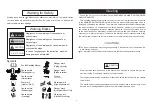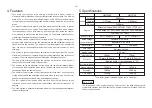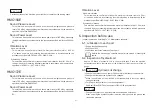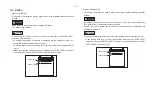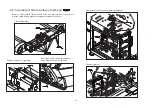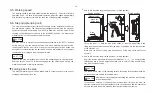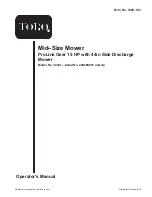
-4-
4. Maintenance and Storage
Disengage drives on level ground, lower the atattachments, set parking brake, stop
engine and remove key from ignition. Wait for all movement to stop before adjusting,
cleaning or repairing.
When machine is to be parked, stored, or left unattended, lower the cutting units
unless a positive mechanical lock is provided.
To reduce the fire hazard, keep the engine, silencer/muffler, battery compartment
fuel storage area, cutting units and drives free of grass, leaves, or excessive grease.
Clean up oil or fuel spillage.
Allow the engine to cool before storing in any enclosure.
Only cover the machine with a sheet after hot parts have sufficiently cooled down.
Never store the equipment with fuel in the tank inside a building where fumes may
reach an open flame or spark.
If the engine is provided with a shut-off valve,shut off valve while storing or
transporting.
Do not store fuel near flames.
Never allow untrained personnel to service machine.
Appropriately manage and correctly use the tools necessary for servicing or adjusting
the machine.
Use jack stands to support components when required.
Carefully release pressure from components with stored energy.
Be sure to depressurize the hydraulic system before performing maintenance
operations on it such as removing hydraulic equipment.
Check whether line connectors in the hydraulic system are properly tightened. Before
applying hydraulic pressure, check the connections of the hydraulic pressure lines
and the condition of the hoses.
When checking the hydraulic circuit for pinhole leaks or oil leakage from nozzles, do
not use your hands. Use items such as paper or corrugated cardboard to find leakage
points. Be extremely careful with high-pressure oil as it may pierce your skin, resul.
If fluid is injected into the skin it must be surgically removed within a few hours by a
doctor familiar with this form of injury or gangrene may result.
Disconnect battery before making any repairs. Disconnect the negative terminal first
and the positive last. Reconnect positive first and negative last.
Make sure that parts such as wires are not touching each other and that their covers
have not come off.
Use care when checking the blades. Wrap the blades or wear gloves, and use caution
when servicing them. Only replace blades. Never straighten or weld them.
Keep hands and feet away from moving parts. If possible, do not make adjustments
with the engine running.
Charge batteries in an open well ventilated area, away from spark and flames. Unplug
charger before connecting or disconnecting from battery. Wear protective clothing and
use insulated tools.
Keep all parts in good working condition and all hardware tightened. Replace all worn
or damaged decals.
Keep all nuts, bolts and screws tight to be sure the equipment is in safe working
condition.
If the fuel tank has to be drained, do this outdoors.



